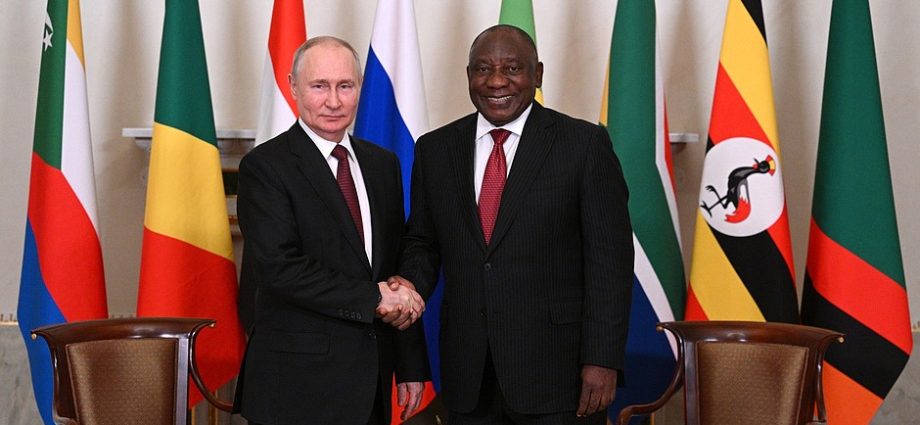
Step back for a moment and ponder the delegation of African leaders that traveled to Kiev and Moscow on a peace mission.
Here were four African heads of state and representatives from countries on all corners of the continent making their way to the belligerents of a European war. Nothing could better demonstrate how Russia’s “special military operation,” a year on, has had global consequences.
Such consequences have led to two public peace plans, and perhaps other private efforts. One came from China and the other from a coalition representing a continent. Neither has been successful, nor come anywhere close to garnering support among the parties to the conflict.
What is demonstrated by the discussions held by African leaders, first with Kiev and then Moscow, is that the two sides remain very far apart. But it is not merely war that separates them: Even what constitutes “peace” remains elusive.
Both the Chinese and African peace plans have floundered because the very nature of what would constitute “peace” is contested. As the war continues, Russia has more and more options for a peace deal, while Ukraine only has one.
The African delegation, led by South African President Cyril Ramaphosa, was deeply consequential. Ramaphosa was there with the presidents of three other countries and the prime minister of Egypt.
In terms of Africans seeking to take charge of a conflict beyond their borders that has nonetheless affected the continent severely, it was politically powerful. But the actual peace plan, like the Chinese plan before it, was disappointing, and turned primarily on confidence-building measures by both sides.
Both Presidents Volodymyr Zelensky and Vladimir Putin raised major objections to it.
Kiev’s maximalist stance
The first major objection raised by Zelensky is one he has reiterated before, but which represents a hardening of the position from the start of the conflict. Zelensky said peace talks would only be possible once Russia had withdrawn from all of Ukrainian territory.
That same formulation has been used in the past, and is often understood to mean not merely recently occupied territories in the east of Ukraine, but also Crimea, which Russia occupied and annexed in 2014.
That position is exactly what one would expect of a wartime government, especially one that has been pushed into a war not of its choosing.
But it is also a maximalist position, one which, followed to its logical conclusion, means not only total Russian withdrawal, but sufficient guarantees, either from Moscow or from Europe, that no conflict would happen again. For Kiev, peace would mean not merely the return of its territory, but a changed Russia.
But “peace” for Russia is a much more amorphous term. Moscow already has frozen conflicts in at least three neighboring countries, Georgia, Azerbaijan and Moldova. It can stand one more.
Frozen conflict
Another option is a “forever war.” This is the scenario Ukraine and the West perhaps fear most.
A frozen conflict would keep Kiev forever in a state of military readiness, unable to dedicate its resources to properly rebuilding. But a forever war would constantly sap Ukraine’s more limited resources, and severely test Western resolve to keep arming the country – especially as elections swept over Western nations, bringing to power new, less invested leaders.
Such a scenario is possible, even likely, because it favors Russia’s military heft. A startling analysis by The Economist last month suggested Russia was only using around 3% of its GDP on the Ukraine war – less than the United States used in the Korean War, which lasted for three years, and not much more than the US spent in Vietnam – which lasted for 20. Time is firmly on Russia’s side.
And that is the essential gap between the two – the nature of the peace they seek. It’s something no peace plan has yet addressed.
Ukraine wants – indeed needs – a permanent peace. Nothing less can be countenanced after the astonishing destruction of the past year of war. It is politically impossible for Kiev to have gone through so much pain and loss, only for the war to pause and resume again in a year or two or five.
But for Russia, a permanent peace isn’t necessary. A piecemeal peace will do.
Russia can make the grain export deal recurring, or work out a prisoner swap. It can stop targeting the Ukrainian capital or freeze the conflict west of the Dnieper River. It could call a truce everywhere but in the occupied and contested areas. All of these are potential versions of “peace,” and all of them are up for negotiation.
The Africa delegation won’t be the last of leaders far from Europe seeking an end to the conflict. Ukraine’s much-vaunted counteroffensive is stuttering. It is hard to see a clear victory for either side even at the end of this year.
If the war doesn’t end, then some version of peace must prevail. But which of the multiple versions of peace will it be – and will any of them be acceptable to a battered and war-weary Ukraine?
This article was provided by Syndication Bureau, which holds copyright.
Faisal Al Yafai is currently writing a book on the Middle East and is a frequent commentator on international TV news networks. He has worked for news outlets such as The Guardian and the BBC, and reported on the Middle East, Eastern Europe, Asia and Africa. Follow him on Twitter @FaisalAlYafai.

